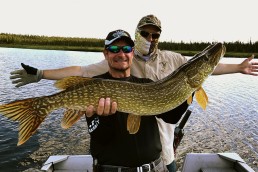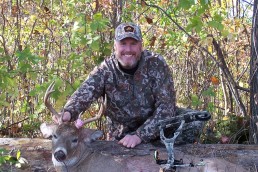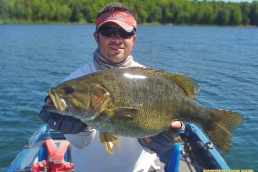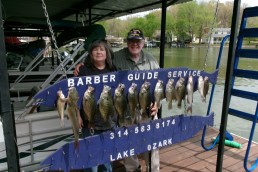Chasing Monster Pike at Minor Bay Lodge
SHARE THIS POST
Some of my most memorable Canadian fishing adventures have involved big pike in far northern Saskatchewan.
Sure, you can catch trophy pike exists in places like Minnesota and Wisconsin and the Canadian provinces of Ontario and Manitoba, but my number one choice for consistent action remains Saskatchewan.
A MidWest Outdoors TV production project at Minor Bay Lodge this past July brought me back to one of my favorite destinations to one again experience the thrill of angling for monster pike. Minor Bay produced my personal biggest pike, a 48-inch beast that chomped on a silver-and-black Vibrax inline spinner.
Tucked into a picturesque bay on the south side of 800-square mile Wollaston Lake in northeastern Saskatchewan, Minor Bay Lodge offers guests access to some of the world’s best trophy pike fishing. The lodge accommodates fewer than 30 guests, which makes for excellent personal service and a super-efficient operation. It also maximizes angling success for guests by putting minimal pressure on key fishing spots located near the lodge. That means more “big bites per guest” and more trophy pike caught and released!
Your adventure starts with a flight to Saskatoon for an initial overnight stay. Early the following morning, you board a jet charter service to Point North Landing. Thereafter it’s a shuttle bus to the lodge for a hot breakfast. Assemble your fishing gear, connect with your guide, and get out on the lake. This is fully guided fishing by experienced professionals who know the best pike locations. Most of Wollaston Lake features vast open water that’s several hundred feet deep. Minor Bay Lodge, however, is situated near the best shallow backwaters and bays, narrow channels, cabbage beds, and tapering shorelines on the entire lake. You fish from 18- or 20-foot boats powered by 50-hp engines that get you safely and quickly to many nearby hotspots.
This far north, the fishing season is short. Most years, Wollaston Lake is not ice-free until around June 1. As the shallows warm up quickly in the late-spring sun, big pike lay in dark-bottom bays to absorb heat and to feed. Redhorse suckers are a primary forage, but northern pike also eat each other. It’s common to catch smaller-size pike displaying fresh bite marks. Smaller pike are in the 30-inch range here, by the way!

In previous July trips to Minor Bay Lodge, I’ve targeted pike in emerging cabbage beds. Broad-leaf cabbage grows extremely fast, and you usually find large weedbeds holding numerous giant pike. Green weeds provide oxygen for the fish and cover for ambushing prey. Cabbage typically grows in 10 to 15 feet of water on the perimeter of the shallow, mud-bottom bays where the pike first lay after ice-out. Cabbage beds also grow near the main lake drop-off, providing quick access to deeper water.
Lake trout and whitefish, other gamefish species on Wollaston Lake, inhabit the deep basin and offer an alternative forage species for big pike. Fisheries biologists speculate that a percentage of the adult pike population resides exclusively in this deep basin all summer, while other northerns migrate back and forth to shallow water, especially drawn to cabbage beds. Weedbeds in bays or along shorelines in close proximity to the deep basin areas are ideal spots. Of course, the guides at Minor Bay Lodge already have these spots located and take you directly to the fish.
An unusually cold spring season last year meant weed growth was way behind the norm for our July TV trip. Water temps hovered in the mid-50s throughout the lake, and many northern pike held in back bays seeking the warmest water. As our intrepid guide Aaron (a 12-year veteran of the lake) boated us from spot to spot in search of the biggest fish, the warmest water we encountered was only 56 degrees. In a normal year, July water temps might touch 70. Cold water slows down the metabolism of the fish, so they eat less and often respond sluggishly to lures. To catch them, slower presentations work best.
The arsenal of tackle for catching Saskatchewan pike varies based on the season and type of cover you fish. When the cabbage beds are in full bloom, topwater, shallow-running lures and soft plastics rigged weedless are ideal options. You can steer these through pockets of open water in cabbage beds or around the weedline perimeter.
You can fish faster presentations in the height of summer when the water is warmest, because pike chase more. However, you need slow and shallow presentations for sluggish, cold-water pike in the shallow backwaters.
Are you enjoying this post?
You can be among the first to get the latest info on where to go, what to use and how to use it!
I have five go-to lures on the boat deck at any time: a No. 5 or No. 6 Blue Fox Vibrax in-line spinner; a topwater lure with an evasive, “walk-the-dog” action, a suspending No. 12 or No. 14 Rapala Husky Jerk, a large-profile crankbait like a Super Shad Rap, and a soft plastic option like a Berkley Jerk Shad. I occasionally use a 6- to 12-inch plastic worm, like I might throw for big largemouth bass.
The new Storm Lures 360GT Searchbait impressed me at Minor Bay Lodge. The larger 5.5-inch size in herring and smelt colors delivered tremendous results for monster pike. The swimbait’s weighted, rattling head, tight wobble and incredibly durable body produced dozens of large northern pike during our Saskatchewan trip.
Truly giant northern pike in far northern waters are an inherently lazy fish, quite contrary to the slashing, toothy attackers inhabiting much warmer water in lower latitudes. The redhorse suckers, lake trout and whitefish that Saskatchewan pike eat weigh 2 to 4 pounds. A trophy pike needs several days for a large meal to digest when cold water slows its metabolism. On these adventures, expect to see more big fish cruising around in the shallows than you’ll actually hook and catch. The fish are well-fed and lazy.
Pike suspend amid the cabbage stalks and lay in warm backwater shallows. I call these fish “knee-knockers” for the thrill they deliver when you first spot them. That thrill intensifies ten-fold when one of these “true giants” starts following your lure back to the boat!
During our trip, we saw a number of “true giants” that clearly exceeded 50 inches (weighing around 30 pounds) that I simply couldn’t get to bite a lure.
Fly anglers often enjoy the greatest success presenting a Black Bunny fly to the biggest, laziest pike. It imitates a large leech pulsing slowly in the water, and giants will follow a Bunny on their nose, sometimes flaring their huge gills to slurp in the offering. You might need multiple casts to trigger a strike, but that is part of the overall experience when you’re fishing at the Home of the Monster Pike.
All in all, for our trip we tallied around 300 northern pike caught and released in five days—with dozens upon dozens of large specimens in the mix. Saskatchewan at Minor Bay Lodge once again delivered an unforgettable pike fishing adventure.
For more information:
1-888-BIG-PIKE
MWO
SHARE THIS POST
Did you enjoy this post?
You can be among the first to get the latest info on where to go, what to use and how to use it!
MWO
We believe being outdoors is good. With more than 1,000 articles each year, MidWest Outdoors magazine is all about sharing outdoor experiences with you—where to go, what to use and how to use it… whether you’re close to home or on that trip of a lifetime.






